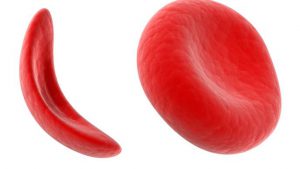What is Sickle Cell Anemia?
Sickle cell anemia is a disease where our blood’s red blood cells became deformed, they become rigid and sticky and their shape becomes like a crescent moon.

It is an inherited condition where both the copy of chromosomes from parents responsible for hemoglobin are mutated and if one is mutated they children will have a sickle cell trait.
What happens to the body while suffering from the disease?
Due to the shape and the properties of normal red blood cells (circular and flexible) they can move easily through tiniest blood vessels,but with sickle cell anemia the properties of red blood cells change and the due to their shape they have a higher chance of forming a clot in the blood vessels, these clots can be dangerous as they can block the flow of blood and oxygen to a certain organ. Due to the shape irregular shape of red blood cells in sickle cell anemia the hemoglobin can spill the oxygen in the bloodstream too, leading to an inadequate supply of oxygen to the organs.

Physical symptoms
This disease has multiple symptoms such as the patient can experience pain in joints, sudden pain in the chest, dizziness, fatigue, low oxygen in the body, malaise, inflamed fingers or toes, pallor, shortness of breath, or yellow skin and eyes and this disease, this disease can also increase the chances of a stroke severely.
How does this disease affect a patient’s daily life?
When suffering from this disease the quality of life of changes a lot, due to repetitive pain in the patients usually also suffer from clinical depression or anxiety which hampers their social relationships of their family and friends, and due to patient’s restrictions in daily functioning and neurocognitive impairment they usually go to behavioral therapy.
Kids suffering from sickle cell usually have stunted growth and late sexual maturity. Any and all major organs are affected by sickle cell disease. The liver, heart, kidneys, gallbladder, eyes, bones, and joints can suffer damage from the sickle cells and their inability to flow through the small blood vessels.
Medical treatments available for this disease?
There are many medications and treatment for pain relieve or stop some symptoms temporarily but this disease does not have any cure. Medications can be narcotics and treatment can involve chemotherapy, blood transfusion and rarely a bone marrow transfusion.
Diagnosis can be often challenging for a genetic disease, the professionals calculate the diagnosis upon the patient’s medical history, symptoms, physical exam, and laboratory test results.

Problems with medical treatment available?
But there are several problems with transplantation of bone marrow and blood transfusion. There can problems vary such as economically, ethically, culturally, socially and geographically. Economically when the patient is not having enough money to get a bone marrow or blood transfusion. Culturally when certain religious activities that forbid transplantation and transfusion. Ethically when people corrupt the system by the primary purpose of gaining profits in terms of doctors or when people pay more to skip the donor list and also the moralistic believes of the patient involved in this is taken into consideration. There can be problems with geography, like where the patient is living and are the hospitals in the area living up the standard or do they have certificates and documentation for certain treatments such as transfusion.
And even if everything above is not an issue, there is a long waiting list for getting the organs and the patient may not have much time left with.